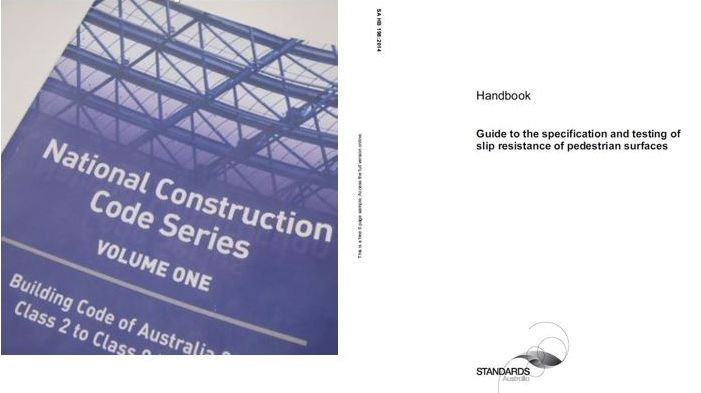Handbook 198 was published in June 2014 to primarily provide guidance to the revisions of the National Construction Codes (NCC) which included mandatory quantification of slip resistance in certain parts of buildings. The slip resistance ratings that are required by the NCC is outlined within HB 198 Table 3A, using the AS 4586-2013 slip testing method of the pendulum and oil wet inclining platform test methods. The new requirements of slip resistance includes stairways for Class 1 residential buildings and stairways and ramps for all other commercial and multi-level residential buildings.
Building Code Slip Resistance Requirements
For internal dry stairs, the tread or nosings should be Pendulum Class P3 or Ramp Class R10, for external stairs, the classifications should be increased by one. In the specification of ramps, they are the same as for stairs, with the exception of those ramps which are greater than 1 in 14, in which the slip resistance ratings are increased by one classification.
It should be noted that the slip resistance requirements in the NCC are for all flooring surfaces. This means that carpet requires to also be tested to the Australian Standard AS 4586 Slip resistance classification of new pedestrian surface materials. Previously the slip resistance of carpet was presumed to be a surface that retained adequate slip resistance.
Ceramic tiles have been tested over the years and there is quite a lot of information relating to the slip ratings, primarily from overseas testing my manufacturers. the slip resistance of timber materials generally have not been tested the same as the hard flooring materials, however there should be more information out given the new building code requirements. Over time, more information will come to hand to provide more generic guidance to carpet and timber suppliers.
ABCB Advisory Note on Slip Resistance
Further guidance is outlined in more detail within the Australian Building Codes Board (ABCB) advisory note 2014-1 ‘Slip‐resistance for Stairways, Landings and Ramps’ dated August 2014. It is important that those involved in supplying material for stairs and ramps are completely familiar with these requirements, and that they have NATA accredited test reports to provide to architects and specifiers to provide evidence that the stone is suitable.
While the ABCB state that the classifications outlined in the NCC do not apply for disability access, it would be prudent to ignore this statement as continuous accessible paths of travel are required to be slip-resistant, through the provisions of AS 1428.1-2009 Design for access and mobility – General requirements for access – New building work. Additionally, designer, specifiers and suppliers of flooring material have a duty of care to provide a reasonably safe surface to prevent injury.
Updates to Standards Australia HB 197
While the NCC and Standards Australia HB 198 provide guidance for the specification and testing of slip resistance of pedestrian surfaces in new building work, there still no guidance to the interpretation of existing surfaces. It is understood that HB 197:1999 is to be undergoing review to provide assistance to the interpretation of slip test results after building construction to assess ongoing risks to slipping. The updated version of HB 197 was initially intended to be released at the same time as the release of AS 4586-2013, AS 4663-2013 and HB 198:2014, however there has been little progress in this regard. We can only hope that this document can be revised in the not too distant future.
Need More Information on Complying with Slip Resistance Requirements
For more information please contact our Sydney or Melbourne office or please leave comments or questions below. I’d be pleased to provide further advice that may assist in regards to slip resistance testing and specification to comply with the Australian Building Codes.
Author: Carl Strautins

Email: Carl@SafeEnvironments.com.au
Web: www.SafeEnvironments.com.au
As a principle at Safe Environments, Carl Strautins first started his career at CSIRO conducting research in slip resistance and developed the accelerated wear slip resistance test. He holds a degree in materials science, masters in occupational health and safety and a masters in science in occupational hygiene, Carl provides guidance to industry to minimise the risk of slip and fall incidents. He is engaged on a regular basis to provide expert opinion for disputes and legal proceedings.


